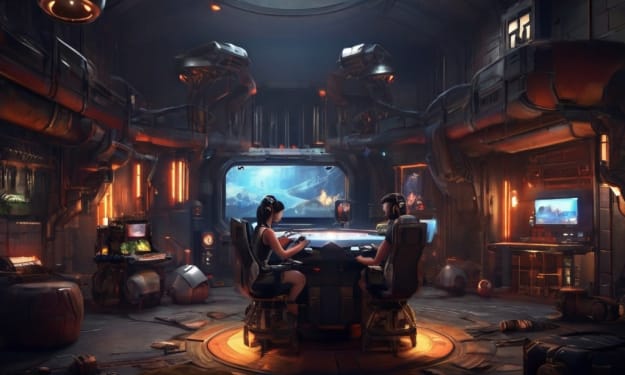Indie Games Versus Triple-A Titans
What makes indie games so popular?

Have you ever felt alone? Someone just wandering and searching for meaning in an industrial world? Do you crave grandma’s home cooking in a world with nothing but fast food? A world of copies of copies of copies.
In recent years the gaming industry has become very similar to that, Ubisoft can churn out the same game about assassins in a different setting year after and still make millions (though they have tried to do something different recently), Call of Duty can still make millions on the same gameplay that came out around 10 years ago, and somehow EA is still in business even with its scummy business tactics and disappointment after disappointment. Many games just feel like copies of copies of copies, with no love or passion ingrained in them, purely a business venture to some, especially with the rise and prominence of microtransactions in everything from Star Wars Battlefront (EA) to Overwatch (Blizzard) to even single-player games like Assassin’s Creed Odyssey (Ubisoft) and Middle Earth Shadow of War (Warner Brothers). To counter that income indie games.
Until relatively recently indie games were incredibly hard to produce and distribute. There were hobbyist games that mostly found their way on flash-gaming sites and then there were huge triple-A titles. That was almost entirely true until a little game called Braid. Braid is a puzzle-platformer, that came out in 2008, that had time-bending mechanics and a mind-bending twist at the end that I won’t spoil. Braid was one of the first indie games to make it big in the gaming world, thanks in part by the onset of the Xbox arcade marketplace and its self-publishing tools. With the rise of digital marketplaces after the Xbox arcade, like Valve’s Steam Marketplace, and even console digital marketplaces, the medium of sale for indie games only became easier.
Another one of the biggest roadblocks hindering indie games early on was money. Triple-A game studios have established bases and generally play it incredibly safe with the titles that they produce and have for a very long time. Other than a few interesting ideas from time to time, mechanics stay relatively similar and many franchises have at least five or six games to them. Indie games are a little more volatile. Without huge studio backings to handle some losses if a game flops indie developers have always walked a tightrope of sorts, if an indie developer fails, they fail, hard. But recently there has been a renaissance of sorts in the gaming world especially with the rise of crowdfunding campaigns and things like Steam Green Light. Crowdfunding platforms like GoFundMe offer a way for the overhead of creating a video game to be covered. Look at crowdfunding success stories like the turn-based RPG dungeon crawler, Darkest Dungeon, in order to see what a little bit of money can do to help bring an otherwise unfathomable game to life. Darkest Dungeon explores what would happen if throw a few damaged, but otherwise perfectly sane, individuals into actual deep, dark, decrepit dungeons full of monsters straight out of eldritch horror. Steam Greenlight is another way for indie developers to get their games the money that they need for development. The way Greenlight works is that it lets developers put unfinished games, usually in the beta testing phase, up for sale in order to help cover development costs. For success stories of Greenlight just look to tough-as-nails artsy survival game, Don’t Starve.
When indie games gained prominence major studios took notice, and instead of trying to drown them they actually offered some aid. Studios like EA and Ubisoft started their own indie game publishing divisions and started helping with the marketing and distribution of indie games, and even took to developing their own like Child of Light and Fe.
What if I told you that the second best selling game of all time was an indie game? An indie game that has sold over 122 million copies and even has its own convention. That game probably needs no introduction, that game being Minecraft. The only game above Minecraft is the classic puzzle game Tetris, with over 170 million copies sold and the only other non-Nintendo games in the top ten are Grand Theft Auto V with over 80 million copies sold, and The Elder Scrolls: Skyrim with over 30 million copies sold. An indie game as the second best selling game of all time obviously shows the true power that a self-created and published title could have but what led to this boom of sorts? For Minecraft, it definitely helps that YouTuber’s took to it like flies on poop. Early pioneers of gaming on YouTube like Seananners posted video after video highlighting the game like one of Seananner's first popular videos, his Minecraft tutorial. Another YouTuber that helped highlight indie games is the YouTuber who still owns the largest YouTube channel on the platform, that YouTuber being Pewdiepie. Some of what helped his popularity on the platform were his videos highlighting his reactions in the survival horror indie game Amnesia: The Dark Descent.
So we see that indie games are popular, almost absurdly so but what causes such popularity? Most triple-A games cost around 60 dollars and that is excluding downloadable content and the now controversial micro-transactions that plague many titles nowadays. In stark contrast come in indie games. According to SteamSpy founder Sergey Galyonkin, the average price for an indie game on the Steam Marketplace is around $8.21 and slips to even less during the common, massive, “Steam sales” on the platform. This low price also includes little to no micro-transactions and affordable if infrequent downloadable content.
Another one of the perks of indie games is a meticulous attention to detail and polish. Indie developers don’t have the safety net that most triple-A developers have so they often only really get one or two chances in a very fickle gaming marketplace. Two examples of games being absolutely obliterated by its less than pleasant release are the crowd-funded Mighty №9 and the hype machine No Man’s Sky. When these games underperformed and didn’t live up to their own hype they were buried under a near-constant stream of bad reviews and outcry by players.
Take the low price and the fact that most indie games are very highly polished when compared to their triple-A counterparts and you have a cocktail of popularity in the works.
Video Games as an Art Form
Famous film critic Roger Ebert infamously said, “Video Games Can Never Be Art,” he continues, “No one in or out of the field has ever been able to cite a game worthy of comparison with the great poets, filmmakers, novelists, and poets.” He was one of the greatest opponents of the perception of video games as art from 2006 all the way until his death in 2013. In the early eras of gaming, he may have been partially correct when games were nothing more than quarter munching time-killers, but modern games, and especially indie games have taken offense to that claim.
What exactly is art though? A quick Google search brings up this, “the expression or application of human creative skill and imagination, typically in a visual form such as painting or sculpture, producing works to be appreciated primarily for their beauty or emotional power,” and “subjects of study primarily concerned with the processes and products of human creativity and social life, such as languages, literature, and history (as contrasted with scientific or technical subjects).” Following that definition nearly any game with some sort of evoking power or beauty could be considered a work of art, so no Pong or PacMan, but to many, the gaming industry is becoming more and more mechanical, less and less personal, and is becoming more focused on money than on powerful emotional pieces. This is why indie games hold a special place for some people, a personal, emotional journey. Take a game like Undertale, for example.
Undertale as a game has an art direction melting with nostalgia, it intertwines old school pixel graphics with a sharp wit that you could struggle to find anywhere outside of Portal. Undertale also sports a massive library of over 100 separately composed songs ranging from spine-chilling songs to epic orchestral pieces, all framing and following the game world around it. That is the thing about indie games, they rely on attention to detail, a passion that only someone pouring all of their love into a project could bring birth to, otherwise, they lose their spark, the thing that differentiates them from every other game on the marketplace. Another example is the game Journey, in which you play a wistful fabric of a protagonist where the player travels through an ocean of sand, completely voiceless. The mute protagonist can run into other players where the only interactions are movements and jumps. The game is entirely alone but somehow still very connected with charming and innocent fun and relaxing music that drives the experience.
Not every game is going to be a deep dive into the human psyche, bringing out the deep-seated childhood trauma that we all want to ignore. Some of these games are going to be dumb, fun, but different. Take the game Death Road to Canada, for example. The game centers around a few people trying to survive a zombie apocalypse on a deadly road trip to Canada almost like a modern Oregon Trail, with different ailments, zombie attacks, and events good and bad that could happen to your group. The game isn’t trying to make a statement, it isn’t trying to be provocative. It has a killer soundtrack but nothing emotionally driving. The game is trying to be fun, and it is trying to be different.
That’s what separates indie game art and the art of triple-A titles like The Last of Us. You aren’t going to go and put a Van Gogh on the fridge but your little sister’s classroom masterpiece? That is going on the fridge for damn sure.
About the Creator
Tim Becker
I spent four years learning how to write about other people but I still don't know how to write about myself.
Journalist, educator, and full-time nerd.






Comments
There are no comments for this story
Be the first to respond and start the conversation.